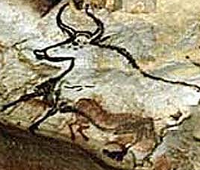Aurochs
|
|
| Aurochs Conservation status: Extinct (1627) | ||||||||||||||||
|---|---|---|---|---|---|---|---|---|---|---|---|---|---|---|---|---|
 Cave painting of aurochs | ||||||||||||||||
| Scientific classification | ||||||||||||||||
| ||||||||||||||||
| Binomial name | ||||||||||||||||
| Bos taurus Bojanus, 1827 |
The aurochs (Bos taurus) is an extinct European mammal of the Bovidae family. The word aurochs is both singular and plural; alternative plural forms are aurochsen or urus. The animal's original scientific name, Bos primigenius, translated the German term Auerochse or Urochs, literally "primeval ox", or "proto-ox". However, this scientific name is now considered invalid by ITIS, who classify aurochs under Bos taurus, the same species as domestic cattle.
| Contents |
Origin
According to the Paleontologisk Museum, University of Oslo, aurochs evolved in India some two million years ago, migrated into the Middle East and further into Asia, and reached Europe about 250,000 years ago. They were once considered a distinct species from modern European cattle (Bos taurus), but more recent taxonomy has rejected this distinction. The South Asian domestic cattle, the zebu, may be descended from a related species, the gaur, although others consider them another descendant species from aurochs. African cattle are thought to have resulted from a third aurochs domestication event, in this case, the domestication of a second group of aurochs closely related to the Near Eastern ones which gave rise to the European cattle. Modern cattle have become much smaller than their wild forebears: the height at the withers of a domesticated cow is about 1.4 meters, whereas an aurochs could reach about 1.75 meters.
The Worship of Aurochs
- See also Bull (mythology).
Aurochs are depicted in many Paleolithic European cave paintings such as those found at Lascaux and Livernon in France. Their life force may have been attributed with magical qualities, for early carvings of the aurochs have also been found. The impressive and dangerous aurochs survived into the Iron Age in Anatolia and the Near East, and was worshiped throughout that area as a sacred animal, the Lunar Bull, associated with the Great Goddess and later with Mithras.
A 1999 archaeological dig in Peterborough, England, uncovered the skull of an aurochs. The front part of the skull had been removed but the horns remained attached. The supposition is that the killing of the aurochs in this instance was a sacrificial act.
The Aurochs were also the symbol of Moldavia; nowadays they can be found in the coat of arms of both Romania and Moldova.
Domestication and Disappearance
Domestication of the aurochs began in the southern Caucasus and northern Mesopotamia from about the 6th millennium BC, while genetic evidence suggests that aurochs were independently domesticated in northern Africa and in India. Domestication caused dramatic changes to the physiology of the creatures, to the extent that domestic cattle must now be regarded as a separate species (see above).
Genetic analysis has provided many insights about the aurochs. Though aurochs became extinct in Britain during the Bronze age, analysis of bones from aurochs that lived contemporaneously with domesticated cattle there showed no genetic contribution to modern breeds. So modern European cattle are thought to be descended directly from the Near East domestication event. Indian cattle (zebu), although domesticated eight to ten thousand years ago, are related to aurochs which diverged from the Near Eastern ones some 200,000 years ago. The African cattle are thought to descend from aurochs more closely related to the Near Eastern ones. The Near East and African aurochs groups are thought to have split some 25,000 years ago, probably 15,000 years before domestication. The "Turano-Mongolian" type of cattle now found in Northern China, Mongolia, Korea and Japan may represent a fourth domestication event (and a third event among Bos taurus–type aurochs). This group may have diverged from the Near East group some 35,000 years ago. Whether these separate genetic populations would have equated to separate subspecies is unclear.
The original range of the aurochs was from the British Isles, to Africa, the Middle East, India and central Asia. By the 13th century, the aurochs' range was restricted to Poland, Lithuania and East Prussia. The right to hunt large animals on any land was restricted to nobles and gradually to the royal household. As the population of aurochs declined, hunting ceased but the royal court still required gamekeepers to provide open fields for the aurochs to graze in. The gamekeepers were exempted from local taxes in exchange for their service and a decree made poaching an aurochs punishable by death. In 1564, the gamekeepers knew of only 38 animals, according to the royal survey. The last recorded live auroch (female) had died in 1627 in the Jaktorów Forest, Poland.
In the 1920s two German zookeepers, the brothers Heinz and Lutz Heck, attempted to breed the aurochs back into existence from the domestic cattle that were their descendants. Their plan was based on the pre-Darwinian conception of 'atavism', according to which "primitive" traits might reappear as 'throwbacks' to an earlier form. The result is the breed called Heck Cattle, 'Recreated Aurochs', or 'Heck Aurochs', which bears an incomplete resemblance to what is known about the physiology of the wild aurochs.
References
- Don E. Wilson and DeeAnn M. Reeder; Mammals
See also
External links
- History of aurochs in Poland (http://www.aristotle.net/~swarmack/aurohist.html)
- Aurochs: Bringing Them Back (http://astronaut.agoff.umn.edu/ansc3221/aurochs/)da:Urokse
de:Auerochse eo:Uro fr:Aurochs he:שור הבר האירופי it:Uro nl:Oeros pl:Tur pt:Auroque ro:Bour fi:Alkuhärkä sv:Uroxe
